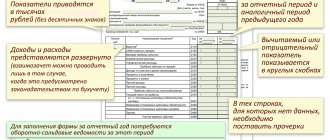Two types of liquidation balances
The procedure for liquidating a company takes a lot of time and effort. It is required not only to comply with all legislative norms of an organizational nature provided for by civil law, but also to fulfill a number of reporting and information duties. These include drawing up liquidation balance sheets and submitting them to the tax authority.
Brief description of liquidation balance sheets:
The liquidation commission or liquidator draws up such a balance. The law defines a set of information reflected in the interim liquidation balance sheet:
The responsibility for drawing up the final liquidation balance sheet and submitting it to the tax authority also lies with the liquidation commission or liquidator (clause 6 of Article 63 of the Tax Code of the Russian Federation).
Period codes on the cover page of the calculation
The calculation of insurance premiums, the form of which has been filled out since 2022 for the purpose of sending reports to the Federal Tax Service, includes, among other things, a title page. On the title page, policyholders (organizations or individual entrepreneurs) need to fill in all fields except the section “To be completed by a tax authority employee.” On the title page there are fields “Calculation (reporting) period and “Calendar year”.
In the “Calculation (reporting) period” field you need to reflect the code of the period for which the calculation is being submitted. These codes are indicated in Appendix No. 3 to the Procedure for filling out a single calculation for insurance premiums. Here is a table of these codes with their explanation:
| Code | Name |
| 21 | 1st quarter |
| 31 | half year |
| 33 | nine month |
| 34 | year |
| 51 | 1st quarter during reorganization (liquidation) of the organization |
| 52 | half a year during reorganization (liquidation) of the organization |
| 53 | 9 months upon reorganization (liquidation) of an organization |
| 90 | year during reorganization (liquidation) of the organization |
In the “calendar year” field, indicate the year in which you submit your insurance premium calculation. Accordingly, if you submit a calculation, for example, for the 1st quarter of 2022, then filling out the title page and the billing period codes on it may look like this:
Please be aware that period codes have changed as of 2022. Previously, when you submitted RSV-1 calculations, other codes were used:
- 3 – for the first quarter;
- 6 – for half a year;
- 9 – in nine months;
- 0 – per year.
Liquidation balance sheet form
The Federal Tax Service, in a letter dated November 25, 2019 No. VD [email protected], provided the form of liquidation balance sheet recommended for use: However, it is not legally prohibited to use any form of reporting to prepare a liquidation balance sheet that can be generated in accounting programs or downloaded from legal databases, specifying in the title, that the reporting is liquidation.
Sample liquidation balance sheet (head part):
Can the liquidation balance be zero?
A completely zero liquidation balance is extremely rare.
If we assume that the company did not operate for a long period, such a balance sheet indicator as “Authorized capital” (p. 1310) cannot disappear anywhere before settlements with the owners and zero indicators can only be at the end of the reporting period. We can also assume that at the end of December all account balances became zero, and the liquidation balance was turned over at the beginning of January. Then the balance can be considered zero, but this is a unique case.
Often it is difficult to call the balance zero - there remains an uncovered loss or unclaimed accounts payable. Or there is retained earnings, compensated by uncollected receivables, the statute of limitations for which has not expired and cannot yet be written off.
Making a completely zero final balance - a balance after transferring property to the owners - is a pointless exercise. Such a balance does not carry any information load and is of no use to anyone.
Sample of filling out a zero liquidation balance
Considering that an absolutely zero liquidation balance is a unique phenomenon, in most cases simply taking a balance sheet and putting zeros or dashes in it on all lines and columns will not work.
The balance sheet (liquidation or regular) includes indicators not only for the last reporting period, but also data for the previous two years (clause 10 of PBU 4/99). Even if at the time of formation of the liquidation balance sheet the balances on all accounting accounts are zero, opening balances in most cases cannot be zero.
View a sample of a zero liquidation balance - 2020
This sample of filling out the liquidation balance sheet - 2022 was compiled for a company with zero balances on all accounting accounts at the time of liquidation. At the same time, at the beginning of the year, the balance sheet asset contained only the amount of money in the current account, from which during the year (until the moment of liquidation) the founders were paid the debt on the contribution to the authorized capital.
How is the tax period determined: code in tax accounting
There are periods of time for which you need to report and provide a calculation of the tax base, they are called tax periods:
- month,
- quarter (from 1st to 4th),
- half-year (first, second),
- year.
The main reports are submitted based on the results of work for the year. The tax period is indicated in the declaration: code 34.
The quarters are assigned separate codes, the code begins with a two, followed by a number indicating the serial number of the quarter. For quarterly reporting, codes from 21 to 24 are used. So for the first quarter - code 21, tax period 22 for the second quarter, 23 for the third, tax period 24 for the fourth quarter.
Some taxpayers report monthly. It should be taken into account that different codes are provided for individual taxpayers and for a consolidated group. If payment is made by a consolidated group, then encryption is accepted from 13 to 15, from quarter to year. The periods from January to December are marked from 57 to 68.
On what date is the liquidation balance sheet compiled?
Specific dates for drawing up the liquidation balance sheet are not regulated by law. But taking into account the procedure for liquidating a company provided for in the Civil Code of the Russian Federation, we will name the following deadlines:
- for the interim liquidation balance sheet - the end date of the deadlines for identifying creditors and completing procedures to establish the actual condition of the property based on the results of the inventory;
- for the final liquidation balance sheet - the nearest date after the creditors' claims are satisfied.
In any case, the date of compilation of the liquidation balance sheet precedes the date of formation of the final (last) statements class=”aligncenter” width=”675″ height=”342″[/img]
Do I need to stamp it?
The legislation does not directly say whether it is necessary or not to put a stamp on the liquidation balance sheet. In the absence of special reservations, one remains guided by the general rules for the preparation of financial statements and the use of seals in the company:
- The accounting statements are considered compiled after the paper copy is signed by the head of the company (clause 8, article 13 of the law “On Accounting” dated December 6, 2011, clause 17 PBU 4/99 “Accounting statements of the organization”). These regulatory documents say nothing about mandatory stamping.
- The balance sheet form itself does not indicate a place for affixing a stamp.
- Joint-stock companies and LLCs have the right (but are not required) to have a seal - information about the presence of a seal must be contained in the company’s charter (clauses 2 and 6 of Law No. 82-FZ dated 04/06/2015).
Thus, the company has the right to put a stamp on the liquidation balance sheet if it uses it in its activities. But even without a seal, this report does not lose its status as an official document if signed by an authorized person.
If federal law provides for the company’s obligation to use a seal, it is better to affix it on the liquidation balance sheet (for example, see paragraph 5 of Article 2 of the Law “On Limited Liability Companies” dated 02/08/1998 No. 14-FZ).
Drafting rules for state employees
Budgetary institutions form a liquidation (separation) balance sheet in the form OKUD 0503830 (approved by Order of the Ministry of Finance of the Russian Federation No. 33n dated March 25, 2011).
Let's look at the question of how to draw up final reporting upon the liquidation of a budget organization.
When carrying out such a procedure, immediately before the formation of the OLB, all funds, assets, liabilities and obligations of the accounting system are subject to mandatory inventory (Article 11 402-FZ). During the inventory count, the actual value for each item is determined. The results entered into the protocol are compared with current data from primary accounting documents. The results of the inventory carried out before liquidation are carried out in the OLS (clause 82 of the GHS “Conceptual Framework”).
All final financial statements must be generated according to information from accounting registers (clause 7 of the Federal Standard, approved by Order of the Ministry of Finance No. 260n dated December 31, 2016). It is compiled in terms of codes for the type of financial security - KFO. All data at the beginning of the reporting period must strictly correspond to the final balance sheet information for the previous accounting year. The final information in the LB is indicated without taking into account final transactions and turnover. The separating BB is compiled according to clauses 14-21 of Instruction No. 33n.
The composition of the financial statements of a liquidated budgetary institution will be as follows (clause 77 of Instruction 33n):
- separation (liquidation) BB - according to form 0503830;
- certificate of consolidated settlements - f. 0503725;
- certificate of conclusion by the institution of accounting accounts for the reporting financial year - f. 0503710;
- report on the institution's implementation of its financial and economic activity plan - f. 0503737;
- report on the obligations of the institution - f. 0503738;
- report on the financial results of the institution - f. 0503721;
- explanatory note - f. 0503760.
In addition to the tax inspectorate, the OBL must be provided to the founder, whose subordinate institution is the liquidated budget organization.
How to submit a liquidation balance sheet to the tax office
The fact that the liquidator has drawn up a liquidation balance sheet must be reported to the tax authority by submitting a special notification. Moreover, the form of notification differs depending on the type of liquidation balance sheet:
Documents related to the liquidation of a company are submitted to the tax office in the following ways:
When submitting electronically, sample documents must be scanned (subject to certain technical requirements) and certified with a digital signature of the liquidator or notary.
What is ILB (interim liquidation balance sheet)? Code 90 or 94?
Reading time: 6 minutes(s) In the process of liquidating an enterprise, authorized persons need to perform quite a lot of different actions and draw up a large package of documents, without which the final decision on liquidation will not be made.
One of such documents is the liquidation balance sheet, which can be interim or final. We will talk about why an interim liquidation balance sheet is needed in this article.
Interim liquidation balance sheet - what is it?
The liquidation balance sheet is an accounting document that is drawn up in the process of liquidating an enterprise in order to determine the actual property state of affairs. The interim liquidation balance sheet is drawn up 2 months from the date of publication of the notice of liquidation in the State Registration Bulletin.
Preliminary preparation of data for the document and its preparation itself, due to certain specifics, often falls on the shoulders of accounting workers, although formally this procedure should be performed by the liquidation commission (clause 1 of Article 63 of the Civil Code of the Russian Federation).
This form of reporting is necessary in order to understand how much property the company has, how much funds, what requirements and conditions the creditors have stated, and what the company’s receivables are. All this is intended to demonstrate whether the organization has enough funds to pay off its debts and liquidate the company. Otherwise, after this procedure, the liquidator must apply to the arbitration court with a demand for bankruptcy of the debtor being liquidated.
The document must include the following information:
- property of the liquidated company;
- requirements accepted by the commission that are presented by creditors;
- claims that were satisfied by a court decision, regardless of whether such conditions were accepted by the liquidation commission.
Information about property must be confirmed by inventory materials (clause 27 of the Regulations “On Accounting and Accounting Reports”, approved by Order of the Ministry of Finance No. 34). Typically, a list of claims and their results of consideration by the liquidation commission are given in the appendix to the balance sheet.
Often, the PLB is approved by the founders (participants) of the legal entity or the body that made the decision on liquidation. In a number of cases, this liquidation balance sheet is approved in agreement with authorized government agencies, in the manner prescribed by paragraph 2 of Article 63 of the Civil Code of the Russian Federation.
It is worth noting that if at least one of the following conditions is present, the PBL should not be approved:
- the court accepted the claim of one of the creditors against the liquidated enterprise and the decision has not yet entered into legal force;
- An on-site tax audit is being carried out in relation to the liquidated enterprise, the final document based on the results of which has not yet entered into force.
The legislation does not prohibit approving the PLB in such cases, however, if at least one of them exists, it will not be possible to submit a notification of preparation to the tax authority (clause 4 of Article 20 of the Law “On State Registration” No. 129-FZ).
It should be noted that a separate form for the interim liquidation balance sheet is not provided for by current legislation (letter of the Federal Tax Service dated August 7, 2012 No. SA-4-7-13101). That is why most often when drawing up documents, a standard balance sheet form is used, which was approved by order of the Ministry of Finance dated July 2, 2010 No. 66n.
Can it be zero?
Since the PLB is compiled at the stage of termination of the enterprise’s activities, which involves the process of selling property and settling obligations, as well as receiving receivables, this form of reporting cannot be zero.
It should be understood that the PLB includes only claims for which there are no disputes between the company and creditors regarding the existence of debt or its size. Disputed accounts payable are not included in these reports (according to the resolution of the Presidium of the Supreme Arbitration Court of the Russian Federation dated April 8, 2004).
The only option in which the PLB will be zero presupposes that the company has no property, money in its accounts or in the cash register, accounts receivable and payable. In this case, the loss will be equal to the amount of the authorized capital.
If, after the restoration of accounting and the end of the period for submitting claims by creditors, it turns out that there is a loss equal to the amount of the authorized capital, then the balance of the interim LP will be zero. In this case, in the balance sheet liability on the line “Authorized capital” there will be an amount with a plus sign, and on the line “Retained earnings (uncovered loss)” the same amount with a minus sign.
If this is not the case, this means that when compiling the accounting, gross errors were made or some liabilities or assets were not entered that the accountant will have to identify.
Code 90 or 94?
Accountants who compile PLB usually use the 1C program. Most often, at the registration stage, using electronic submission, you can print a form with a two-dimensional barcode PDF-417, which is issued from the download file. On such a form, in the “Reporting code” field, code 90 or 94 is entered, depending on the type of financial statements generated.
Code 90 will correspond to the final liquidation balance sheet, code 94 to the interim balance sheet.
On what date is it compiled?
An interim balance sheet is drawn up 2 months after the official publication of the commencement of liquidation of the company. The document is executed after notification of creditors about the upcoming liquidation and the end of the period for filing financial claims against the organization. The closing date for accepting claims is always indicated in the publication.
The interim balance is drawn up by the liquidation company, whose responsibilities will include conducting an inventory, preparing documents and generating reporting data. It follows from this that the company can draw up a PLB for the reporting date or any other date, but authorized persons must correctly calculate the timing and their capabilities to carry out all the necessary procedures.
It should be noted that an organization can draw up several balance sheets, and the frequency of their preparation will be determined by the needs of the liquidated company.
Who signs?
From the moment the founder of the company decides to liquidate it, all issues related to this procedure are dealt with by a specially authorized person or group of persons - the liquidator or the liquidation commission. It is these professionals who will perform all leadership and representation tasks on behalf of the organization. In addition, the decision to approve the PLB can be made by the only participant (founder).
Accordingly, the responsibilities of these employees include monitoring reporting at each stage of liquidation. The signature of the liquidator or the chairman of the liquidation commission must be on all reports (accounting and tax payments), including the protocol on approval of the interim liquidation balance sheet. In addition, the liquidator will be responsible for the timely submission of reports.
Where to rent?
Despite the fact that in Law No. 129-FZ there is no direct specific reference to the obligation of a liquidated company to hand over the PLB to the registration authority, it is still required to be handed over by an authorized person.
Without an interim balance sheet, it will become impossible in the future to confirm the reliability of the final balance sheet, and its authenticity is a necessary condition for the liquidation of the organization and the termination of its work.
Do I need to submit it to the tax office?
The interim liquidation balance sheet must be submitted to the registration authority - the tax office. Submission of the interim liquidation balance sheet to the tax office is accompanied by the submission of the following package of documents:
- notification of liquidation of a legal entity in form P15003 with a mandatory note that it is being submitted in connection with the preparation of the PLB in accordance with Appendix No. 8 by order of the Federal Tax Service dated January 25, 2012 No. MMV S7-6-25;
- list of conditions stated by creditors;
- list of property of the liquidated organization.
You should pay close attention to the fact that the P15003 form is filled out according to the same rules that will apply for preparing tax reporting. The form is usually typewritten, in capital letters, in empty columns. This document must be certified by a notary, for which the specialist may also need an extract from the registration register, the charter of the organization, a protocol on the appointment of the head of the company.
When is it served?
The interim report is drawn up two months after the publication of the notice about the beginning of the liquidation of the enterprise. Registration is carried out immediately after notifications are sent to all creditors about the upcoming closure of the enterprise and the end of the deadline for filing financial claims. The end date must be indicated in the publication in the State Registration Bulletin. The organization has the right to begin preparing this type of reporting the very next day after the end of the claim submission period.
It should be understood that this form involves determining the actual values for mutual settlements with counterparties, assets and liabilities, and the value of the organization’s property. The PLB can be issued on any date, and it is possible to register and submit it to the tax office more than once. Most often, the PLB is drawn up and submitted to the tax office just before the end of the financial year.
Is it possible to submit an interim and liquidation balance at the same time?
According to Article 63 of the Civil Code of the Russian Federation, a company must separately submit an interim and final liquidation balance sheet. This is explained by the fact that these documents have different purposes and different indicators, since the first of them is drawn up for settlements with creditors, and the second later to determine the remaining property.
Violation of the mandatory procedure for liquidation can result in a refusal to close the enterprise and termination of the organization’s activities or its invalidity.
Thus, the simultaneous provision of two balances is not provided, since they are issued on different dates and at different periods of time. However, some lawyers and tax specialists allow such documents to be submitted simultaneously, but the date of approval of the final LB must be later than the date of approval of the interim LB. However, authorized persons from the organization should be prepared for the fact that if the PLP contains shortcomings and a refusal is received, then the final version of the document will also not be considered.
Where can I find a sample approval decision?
You can find a sample resolution and PLB at the following link: https://yadi.sk/i/JbWDdUX1oyvhzw
In conclusion, it should be noted that in accounting work there are many types of balance sheets. Among these forms there is also an interim liquidation balance sheet - these statements are designed to analyze the financial condition of the company at the time of termination of its activities.
The document contains information about the availability of property of the enterprise that is to cease its activities, as well as about the claims of creditors. It is compiled by a member of the commission for liquidation of legal entities.
Did this article help you? We would be grateful for your rating:
0 0
So:
Drawing up a liquidation balance sheet is a mandatory procedure when liquidating a company.
There are two types of liquidation balance sheets: interim and final. Each balance sheet has its own purpose and is signed by the head of the liquidation commission, the appointed liquidator or bankruptcy trustee (in case of bankruptcy of the company). The final liquidation balance sheet must be submitted to the tax office along with an application for state registration of a legal entity in connection with its liquidation. Hello Guest! Offer from "Clerk"
Online professional retraining “Accountant on the simplified tax system” with a diploma for 250 academic hours . Learn everything new to avoid mistakes. Online training for 2 months, the stream starts on March 1.
Sign up
Tax period: code when calculating property tax
When reporting on this tax, it is not always necessary to submit interim reports; as a result, payment is made immediately for the year. The coding will be the same as for reporting on other taxes.
When preparing reports, code 21 is used (tax period - quarter), half-year - tax period - code 31, when calculating tax for 9 months, tax period 33 is indicated.
When liquidating an enterprise, codes 51, 52, 53 are used, they mean a quarter, half a year, 9 months.






